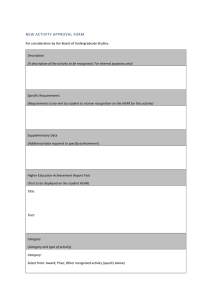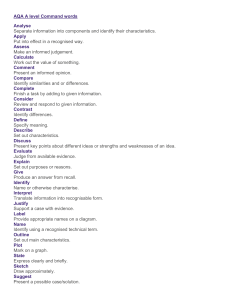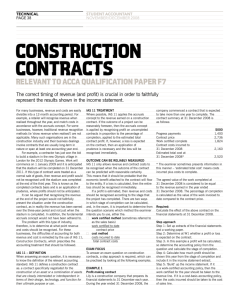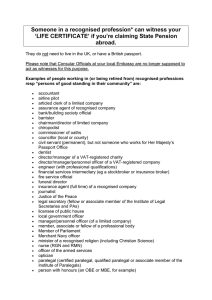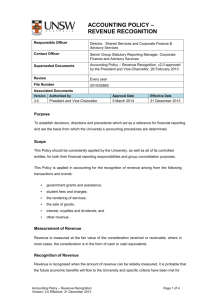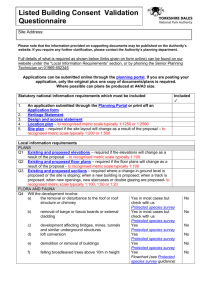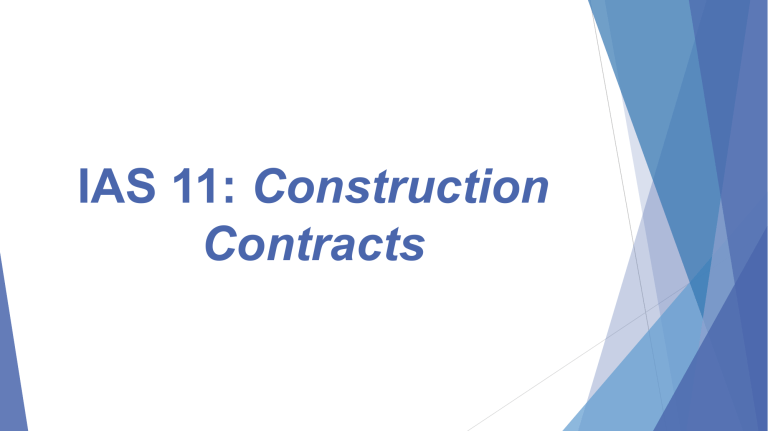
IAS 11: Construction Contracts Background Effective for periods beginning on or after 1 January 1995 Prior to that revenue was recognised at the completion of contract and costs were recognised when incurred This caused a conflict , not in line with the accrual method Was excessively prudent Objective To prescribe the accounting treatment of revenue and costs associated with construction contracts. Contracts are seldom completed within a financial period Hence IAS11 prescribes the method of recognising the costs and revenues attributable to a specific contract Adopts the accrual method of accounting Construction contract Is a contract specifically negotiated for the construction of an asset or a combination of assets that are closely interrelated or interdependent in terms of their design, technology and function or their ultimate purpose or use. Construction contract (contd.) Construction contracts include contracts for: • Rendering of services directly related to the construction of the asset (i.e., for project managers and architects); and • The destruction or restoration of assets, and the restoration of the environment following the demolition of assets. Types of Contracts Fixed price contract: is a construction contract in which the contractor agrees to a fixed contract price, or a fixed rate per unit of output, which in some cases is subject to cost escalation clauses. . Types of Contracts Cost-plus contract: is a construction contract in which the contractor is reimbursed for allowable or otherwise defined costs, plus a percentage of these costs or a fixed fee. • A contract may be a single contract e.g. construction of a bridge or dam and can be a contract for a series of contracts, which are closely interrelated or interdependent in terms of design, technology or construction. Contract Revenue • • the initial amount of revenue agreed in the contract; and variations , claims and incentive payments: ‐ to the extent that it is probable that they will result in revenue; and ‐ they can be reliably measured. Contract revenue measurement Contract revenue is measured at the fair value of the consideration received or receivable. The measurement of revenue is affected by a variety of uncertainties that depend on the outcome of future events. These estimates are revised as and when the events occur and impact on the revenue to be recognised in the different financial periods over the life of the contract Contract revenue measurement Variations are included in the revenue when: it is probable that the customer will approve the variation/amount of revenue arising from variation; and the amount of revenue can be measured reliably. Claims are included in the revenue only when: negotiations have reached the advanced stage and it is probable that the customer will accept the claim; and the amount probable to be accepted by the customer can be measured reliably. Incentive payments are included in the revenue when: the contract is sufficiently advanced that it is probable that the specified performance standards will be met or exceeded; and the amount of incentive payments can be measured reliably. Contract costs • costs that relate directly to the specific contract e,g labour, materials, supervision • costs that are attributable to contract activity in general and can be allocated to the contract; and • such other costs as are specifically chargeable to the customer under the terms of the contract. • Cost of rectification after completion Contract costs (contd.) Contract costs do not include the following: General administration costs (unless reimbursement is specified in contract); Selling costs; R&D costs (unless reimbursement is specified in contract); and Depreciation of idle plant and equipment not used on any particular contract. Contract costs measurement Generally contract activity costs should be allocated systematically and rationally, and all costs with similar characteristics should be treated consistently. The allocation should be based on the normal level of construction activity. When it is probable that total contract costs will exceed total contract revenue, the expected loss shall be recognised as an expense immediately. ACCOUNTING TREATMENT Percentage of completion method When the outcome of a contract can be estimated reliably, the contract revenue and costs should be recognised according to the stage of completion of the contract. The percentage of completion method is an application of the accruals assumption. Contract revenue is matched to the contract costs incurred in reaching the stage of completion, so revenue, costs and profit are attributed to the proportion of work completed. Percentage of completion method (Cont’d.) We can summarise the treatment as follows: • • • • • Recognise contract revenue as revenue in the accounting periods in which the work is performed; Recognise contract costs as an expense in the accounting period in which the work to which they relate is performed; Any expected excess of total contract costs over total contract revenue (ie a loss) should be recognised as an expense immediately; Any costs incurred which relate to future activity should be recognised as an asset if it is probable that they will be recovered (often called contract work in progress, ie amounts due from the customer); and Where amounts have been recognised as contract revenue, but their collectability from the customer becomes doubtful, such amounts should be recognised as an expense, not a deduction from revenue. Determining the stage of completion How should you decide on the stage of completion of any contract? IAS 11 gives 3 methods: Proportion of contract costs incurred for work carried out to date; Costs to date/Total estimated costs Surveys of work carried out Work certified/Contract price Physical proportion of the contract work completed Contract outcome predictability When the contract's outcome cannot be predicted reliably: • only recognise revenue to the extent of contract costs incurred which are expected to be recoverable; and • recognise contract costs as an expense in the period they are incurred. This no profit/no loss approach reflects the situation near the beginning of a contract, ie the outcome cannot be reliably estimated, but it is likely that costs will be recovered. Recognition of expected losses Any loss on a contract should be recognised as soon as it is foreseen. The loss will be the amount by which total expected contract revenue is exceeded by total expected contract costs. The loss amount is not affected by whether work has started on the contract, the stage of completion of the work or profits on other contracts (unless they are related contracts treated as a single contract). Changes in estimates The effect of any change in the estimate of contract revenue or costs or the outcome of a contract should be accounted for as a change in accounting estimate under IAS 8 Accounting policies, changes in accounting estimates and errors. Example A contract is started on 1 March 2016 and is due for completion on 31 December 2017 • Contract value of $1,500,000 • Costs incurred for the year ended 31 December 2016 amount to $600,000 • Certified work as at 31 December 2016 is $750,000 • It is estimated with certainty that costs to completion amount to $600,000 or $1,000,000 What is the contract revenue and profit to be recognised in the financial statements for the year ended 31 December 2016 Disclosure An entity must disclose the following in the notes to the financial statements: • The methods used to determine the contract revenue recognised in the period; • The amount of contract revenue recognised as revenue in the period; • The method used to determine the stage of completion of contracts in progress; Disclosure • The gross amount due from the customers for contract work as an asset; and • The gross amount due to the customers for contract work as a liability. Disclosure Further disclosure is required for: Contracts in progress at the end of the reporting period, show the following: • Total costs incurred plus recognised profits (less recognised losses) to date; • Advances received; • Retentions (progress billings not paid until the satisfaction of certain conditions); and Disclosure • Any contingent gains or losses, eg due to warranty costs, claims, penalties or possible losses, should be disclosed in accordance with IAS 37 Provisions, contingent liabilities and contingent assets. IFRS 15: Revenue from Contracts with Customers Background As a result of the issuance of IFRS 15, the following existing requirements in IFRSs have been superseded: • IAS 11 Construction Contracts; • IAS 18 Revenue; • IFRIC 13 Customer Loyalty Programmes; • IFRIC 15 Agreements for the Construction of Real Estate; • IFRIC 18 Transfers of Assets from Customers; and • SIC-31 Revenue – Barter Transactions Involving Advertising Services. Effective date Effective for periods beginning on or after 1 January 2018 Early adoption is permitted . END
